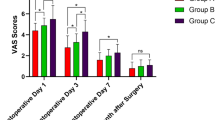Abstract
The effectiveness of two different methods for calculating the arterial occlusion pressure (AOP) to set tourniquet inflation pressures were assessed in patients underwent knee arthroscopy. Eighty patients were included in this study. Tourniquet inflation pressure was set by adding 20 mmHg of safety margin above the AOP value which was calculated by either the Tuncali et al. formula or Hong-yun Liu et al. formula. Primary outcome measures were the initial and maximum SBP, initial and maximum tourniquet inflation pressure, the secondary outcomes were the surgeon rating of the bloodlessness of the surgical field and tourniquet associated complications. There was significant difference in the initial tourniquet pressure (mmHg); it was 208 ± 12 and 262 ± 18 for group (A) and (B) respectively; also there was significant difference in the maximum tourniquet pressure (mmHg), it was 229 ± 14 and 283 ± 19 for group (A) and (B) respectively. There was no significant difference in the initial SBP-to- tourniquet inflation time, the initial SBP or the maximum SBP between the groups. Also, there was no significant difference in surgeon rating of the bloodlessness of the surgical field, at the start, middle and end of surgery. Hong-yun Liu et al. mathematical formula was found to be less effective than Tuncali et al. formula to estimate the least effective tourniquet pressure in lower limb surgery and we might consider it invalid to be used in the lower limb.
Clinical trials registration number: NCT03706859 (Clinicaltrials.gov) and registration date: January, 2019. https://clinicaltrials.gov/ct2/show/NCT03706859

Similar content being viewed by others
Data availability
The datasets generated during and/or analysed during the current study are not publicly available due to confidentiality of FM-BSU files but are available from the corresponding author on reasonable request.
References
Smith TO, Hing CB. Is a tourniquet beneficial in total knee replacement surgery? A meta-analysis and systematic review. Knee. 2010;17:141–7.
Oragui E, Parsons A, White T, Longo UG, Khan WS. Tourniquet use in upper limb surgery. Hand. 2011;6:165–73.
Odinsson A, Finsen V. Tourniquet use and its complications in Norway. J Bone Joint Surg Br. 2006;88:1090–2.
Noordin S, McEwen JA, Kragh JF Jr, Eisen A, Masri BA. Surgical tourniquets in orthopaedics. J Bone Joint Surg Am. 2009;91:2958–67.
Tejwani NC, Immerman I, Achan P, Egol KA, McLaurin T. Tourniquet cuff pressure: the gulf between science and practice. J Trauma. 2006;61:1415–8.
Olivecrona C, Lapidus LJ, Benson L, Blomfeldt R. Tourniquet time affects postoperative complications after knee arthroplasty. Int Orthop. 2013;37:827–32.
Lundborg G. Structure and function of the intraneuralmicrovessels as related to trauma, edema formation and nerve function. J Bone JointSurg Am. 1975;57:938–48.
Drolet BC, Okhah Z, Phillips BZ, Christian BP, Akelman E, Katarincic J, Schmidt ST. Evidence for safe tourniquet use in 500 consecutive upper extremity procedures. Hand (N Y). 2014;9:494–8.
Younger AS, Manzary M, Wing KJ, Stothers K. Automated cuff occlusion pressure effect on quality of operative fields in foot and ankle surgery: a randomized prospective study. Foot Ankle Int. 2011;32:239–43.
Newman RJ, Muirhead A. A safe and effective low pressure tourniquet. J Bone Joint Surg Br. 1986;68:625–8.
AORN Recommended Practices Committee. Recommended practices for the use of the pneumatic tourniquet in the perioperative practice setting. AORN J. 2007;86:640–55.
Tuncali B, Karci A, Tuncali BE, Mavioglu O, Ozkan M, Bacakoglu AK, Baydur H, Ekin A, Elar Z. A new method for estimating arterial occlusion pressure in optimizing pneumatic tourniquet inflation pressure. Anesth Analg. 2006;102:1752–7.
Tuncali B, Boya H, Kayhan Z, Araç Ş, Çamurdan MA. Clinical utilization of arterial occlusion pressure estimation method in lower limb surgery: effectiveness of tourniquet pressures. Acta Orthop Traumatol Turc. 2016;50(2):171–7.
Unver B, Karatosun V, Tuncali B. Effects of tourniquet pressure on rehabilitation outcomes in patients undergoing total knee arthroplasty. Orthop Nurs. 2013;32:217e222.
Liu HY, Guo JY, Zhang ZB, Li KY, Wang WD. Development of adaptive pneumatic tourniquet systems based on minimal inflation pressure for upper limb surgeries. Biomed Eng Online. 2013;12:92.
Tuncali B, Boya H, Kayhan Z, Arac S. Tourniquet pressure setting based on limb occlusion pressure determination or arterial occlusion pressure estimation in total knee arthroplasty, a prospective, randomized, double blind trial. Acta Orthop et Traumatol Turc. 2018;52:256–60.
Olivecrona C, Blomfeldt R, Ponzer S, Stanford BR, Nilsson BY. Tourniquet cuff pressure and nerve injury in knee arthroplasty in a bloodless field: a neurophysiological study. Acta Orthop. 2013;84:159–64.
Yalçınkaya M, S€okücü S, Erdo_gan S, Kabukçuo_glu YS. Tourniquet use in orthopedic surgery: a descriptive survey study among Turkish orthopedic surgeons and residents in Istanbul. Acta Orthop Traumatol Turc. 2014;48:483–90.
Boya H, Tuncalı B, €Ozcan O, Araç S, Tuncay C. Practice of tourniquets use in Turkey: a pilot study. Acta Orthop Traumatol Turc. 2016;50:162–70.
Sharma JP, Salhotra R. Tourniquets in orthopedic surgery. Indian J Orthop. 2012;46:377–83.
Funding
The current study was funded by FM-BSU as regards the drug, equipments and data.
Author information
Authors and Affiliations
Contributions
SK and TM put the design and the protocol and shared in the clinical part, AAB and AM shared in writing the manuscript and carried out the statistical data analysis, GA shared in writing the manuscript and revising the data analysis and YAB shared in collecting the background resources and writing the manuscript. All authors read and approved the final manuscript.
Corresponding author
Ethics declarations
Conflict of interest
The authors declare that they have no competing interests.
Ethics approval
The study protocol was approved by the ethical committee of Faculty of medicine, Beni Suef University (FM-BSU), Egypt (approval number 005/2018).
Informed consent
Informed consent was obtained to participate this study from the patients.
Additional information
Publisher's Note
Springer Nature remains neutral with regard to jurisdictional claims in published maps and institutional affiliations.
Rights and permissions
About this article
Cite this article
Kasem, S.A., Al Menesy, T., Badawy, A.A. et al. Comparison between two mathematical methods to estimate arterial occlusion pressure and tourniquet effectiveness in lower limb surgery: a prospective, randomized, double blind, comparative study. J Clin Monit Comput 34, 675–681 (2020). https://doi.org/10.1007/s10877-019-00366-0
Received:
Accepted:
Published:
Issue Date:
DOI: https://doi.org/10.1007/s10877-019-00366-0




